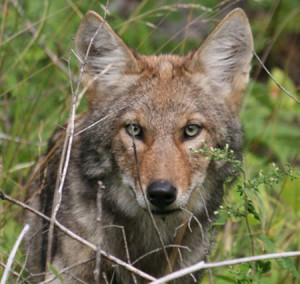 Coyote sightings in residential areas have steadily increased over the past decade. Just this past winter an area deemed a success at co-existing with coyotes saw seven threating encounters between pedestrians and these animals. The rise in population in urban areas is due to the availability of food and shelter. Coyotes will eat pet food, garbage, bird feeders, fallen fruit from trees, and even compost piles. With the close existence of humans and coyotes, attacks on pets make the news regularly. Two states are taking different approaches on how to control and reduce the number of attacks.
Coyote sightings in residential areas have steadily increased over the past decade. Just this past winter an area deemed a success at co-existing with coyotes saw seven threating encounters between pedestrians and these animals. The rise in population in urban areas is due to the availability of food and shelter. Coyotes will eat pet food, garbage, bird feeders, fallen fruit from trees, and even compost piles. With the close existence of humans and coyotes, attacks on pets make the news regularly. Two states are taking different approaches on how to control and reduce the number of attacks.
In Orange Country the answer may become a plan to euthanize some of the coyote population. Huntington Beach, CA saw 26 pet deaths in 2012. In November, Mayor of Huntington Beach Devin Dwyer, proposed to thin out the population. He was met with extreme resistance from residents and the Humane Society of the United States. This would not be the first time Hunting Beach hired trappers, a similar situation occurred in 2010. Unfortunately, coyotes have the ability to replenish their population therefore negating the reasoning.
Denver and surrounding areas have a different approach. They focus on community awareness and “hazing”. Denver is characterized as a success. The goal is to co-exist with the coyote population. However, just this past winter Denver has seen resistance from the coyotes in accepting the co-existence policy. In late December – January, in Boulder, Colorado, bikers and dog walkers experienced threatening behavior from coyotes. A jogger was bitten in the calf, a cyclist was chased, and a dog-walker was “menaced” for a total of seven aggressive interactions. Ten minutes away in Broomfield, Colorado there were eleven pet attacks in 2012. For town officials the answer is still education and hazing.
What are the awareness programs telling residents?
- Prevention: Don’t feed coyotes – even by accident. Don’t leave pet food outside and pick up garbage and fallen fruit.
- Prevention: Don’t leave pets unattended outside. Coyotes can easily jump over a six foot tall fence.
- If confronted: Don’t turn your back on a coyote. If you turn and run, you give the coyote full advantage.
- If confronted: Make loud noises like yelling or banging on pots and pans.
- If confronted: Try to intimidate them by throwing rocks, spraying your hose, and spraying vinegar.
- When in a populated area: Use a walking stick so you can make yourself as big as possible by throwing your hands up in the air and waving the stick.
- If you are not confronted, but can see them from afar – do nothing.
Will humans be able to co-exist with coyotes without putting our pets at risk? So far, it seems the answer is no.






Your question from the beginning is flawed. It is we that need to learn how to live with them. Pets+ dissapearance does NOT equal coyote kill. But it is the first thing that comes to mind in large part because media continues to put them together without any actual proof. Sure it can happen but not nearly as often as it is supposed.
Further, pets should be supervised especially if wildlife is known to come into the area! Not doing so is a diservice to your pet and sometimes local bylaws.
Fortunately no matter how careless or self-entitled some can become, coyotes can be tought to avoid. they call it hazing and should be mainly done by those who understand how without harassing unduly or harming them.
Coyotes are extremely clever and can live beside us for years before many are even aware.
Widlife problems have their root with people and it is our behaviour that is the cause of most conflicts and it is with us that lies the answer.
So the question should really be can we be tought to live in harmony with local wildlife. the answer is yes but people have to want to in order for it to work.
Comments are closed.